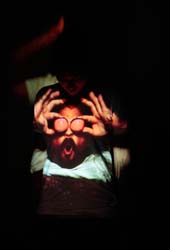
Dorothy Chansky
Highs and Lows of undergroundzero
Review of "The National Diet of Japan" and "L.A.
Party"
at the undergroundzero festival,
a project of East River Commedia
Performance Space 122, 150 1st Avenue (at 9th St.)
July 6-25, 2010
Tickets: $20 regular/$15 students and seniors. www.ps122.org
Reviewed by Dorothy Chansky
Food on the American stage isn't what it used to be, if the offerings
at undergroundzero are any indicator. In place of fully realized restaurants,
family dinners with actual edibles, representations of privation or plenty,
foodie snobbery, fish and vegetables to be juggled, or audience as consumers
of the comestibles, we now have food as index of existential anxiety.
Or maybe just anxiety.
 |
| "The National Diet of Japan." Photo is courtesy of the undergroundzero festival. |
In David Barlow's hilarious and highly original "L.A. Party," a thirty-year-old New York actor (mostly non-working) with more than a tinge of self-righteousness falls off the wagon at an all-out birthday bash for his cool dude cousin on the west coast. The wagon is a deluxe vegan model, but alcohol plays a role here, because the beer that our hero coolly requests as he self-consciously eases in to a warehouse packed with babes and drugs, is the first processed anything he's ingested in two years. This is a purist so devoted to his anti-toxin regime that at Thanksgiving he brings his own electrolyte lemonade and salad rather than hazard the usual family "poison." Sex has eluded him for a year, his enema bag is always hanging on the shower curtain, he makes frozen desserts from imported raw berries in an industrial sized blender, and he has taken on what he proudly calls a "raw glow." This is hubris riding for a fall.
Barlow's métier is storytelling, and in his own voice—complete with sound effects, accents, attitude, and timing that he could bottle and sell—the audience was hooked from the minute he opened his mouth. (The production finished its run after four performances, although the festival continues.) But director Phil Soltanoff has a lot more on his mind than vocal pizzazz and a good yarn. Using live video feed, two other performers, and a hand-held lamp, his production deconstructs the "man at the mic"'s identity with low-tech, high interest panache.
In the center of the playing area, against a wall, a woman in a white tee shirt (Kristine Oakes) sat, her eyes and mouth covered with white tape. On the floor, Ilan Bachrach lay prone, mouthing Barlow's lines and being captured on camera, his face projected onto Oakes's. So, where, exactly, is the source of the story? We see one speaking face projected onto a separate body and listen to a voice clearly emanating from a third person. The effect was Picasso in four dimensions.
For a while. When three beers give way to a joint and then some mushrooms, the rules change. The man on the floor becomes the cousin, and the woman strips off her mask. The speaker continues his story, with the party babes sexier and the guacamole greener than before. Like his stage alter egos, though, he has multiple identities operating simultaneously. I mean, just because you're moving from shrooms to coke is no reason to keep you from feeling so lame because your shirt is actually tucked into your pants, nor to fail to consider that after two years of purity, all these new chemicals could kill you. Wait! Is this really cool dude cousin Jon, or is it the devil? Did those visuals start looking more like the world of Dalí?
 |
| "L.A. Party." Photo is courtesy of the undergroundzero festival. |
Two party venues later, our hero, who has decided to go for the gold, wakes up in a strange apartment, his loyal cousin still at his side. It's an indication of how much Barlow and Soltanoff have pulled us into this multi-ID, power-of-a-story world, that when a portable light is trained on Barlow and we see him for the first time as himself—basically a protean stand-up--it's a shock. This ordinary-looking guy under harsh light took me on that mind-bending, gut-splitting ride?
And then it gets funnier.
I guess you could credit Barlow with a sense for classical dramaturgy of a sort. The play takes place in a single day and by the end, the hero is forever changed, and yes, the actor/raconteur riffs on a couple of Shakespearean moments, but these are no more important than his going wild with food fantasies like "Tempura Tamale Falafel Frittata Tempura Tamale Falafel Frittata" or nodding to a phantom who reads on the page even better than she sounds aloud: Goldy Lox.
Our nerd earns his street creds, pleased with himself for abusing four substances at a time and living to write about it. And now there'll be one more substance. Pancakes never made such a poignant punch line.
In a wholly different vein, a company called Aztec Economy
proffered "The National Diet of Japan," a pretentious, testosterone-driven
meandering of defensive hostility that suggests life is just one big Nintendo
game, and a badly designed one at that. You die and then reset to zero,
says Chief, a shirtless guy with a beer gut and a fake Indian headdress.
In his game, Hatred (sporting a parliamentary wig) argues for turning
our backs on eating and its attendant organs and functions. Grief argues
that vomit and diarrhea are mirror images of each other, with the court
jester-like Asshole (who sports pantyhose in lieu of cap and bells) tossing
out off-the-cuff responses such as "google that." At one point,
the guys hack up a skinned hare (a subject of culinary debate, and for
which I think a chicken was substituted.) While it may be true that we
all "have to play the game," I was ready to hit reset long before
this one was over.
| museums | NYTW mail | recordings | coupons | publications | classified |
